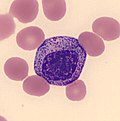Myelocyte
Myelocyte is a young cell in the granulocytic series, occurring normally in bone marrow (but not in the circulating blood), that is the precursor of the metamyelocyte and has a nucleus that is no longer round.
Overview[edit]
The myelocyte is a stage in the development of a granulocyte, following the promyelocyte, and preceding the metamyelocyte. It is characterized by the appearance of specific granules that are primary (azurophilic) granules, which are peroxidase-positive.
Development[edit]
Myelocytes are derived from promyelocytes. They are smaller than promyelocytes. They show large oval nucleus and loose chromatin. The cytoplasm is filled with specific granules (neutrophilic, eosinophilic, or basophilic). Myelocytes do not have nucleoli.
Types[edit]
There are three types of myelocytes: neutrophilic myelocytes, eosinophilic myelocytes, and basophilic myelocytes. These cells are part of the granulocyte series and are identifiable by their granules.
Function[edit]
Myelocytes are not normally found in the peripheral blood, but rather in the bone marrow. They are part of the immune system and play a role in the body's defense against infections.
Clinical significance[edit]
Abnormalities or disorders related to myelocytes can lead to diseases such as leukemia or myeloproliferative neoplasms. An increase in myelocytes (myelocytosis) can be seen in certain infections and conditions.
See also[edit]
References[edit]
<references />
Ad. Transform your life with W8MD's Budget GLP-1 injections from $75


W8MD offers a medical weight loss program to lose weight in Philadelphia. Our physician-supervised medical weight loss provides:
- Weight loss injections in NYC (generic and brand names):
- Zepbound / Mounjaro, Wegovy / Ozempic, Saxenda
- Most insurances accepted or discounted self-pay rates. We will obtain insurance prior authorizations if needed.
- Generic GLP1 weight loss injections from $75 for the starting dose.
- Also offer prescription weight loss medications including Phentermine, Qsymia, Diethylpropion, Contrave etc.
NYC weight loss doctor appointmentsNYC weight loss doctor appointments
Start your NYC weight loss journey today at our NYC medical weight loss and Philadelphia medical weight loss clinics.
- Call 718-946-5500 to lose weight in NYC or for medical weight loss in Philadelphia 215-676-2334.
- Tags:NYC medical weight loss, Philadelphia lose weight Zepbound NYC, Budget GLP1 weight loss injections, Wegovy Philadelphia, Wegovy NYC, Philadelphia medical weight loss, Brookly weight loss and Wegovy NYC
|
WikiMD's Wellness Encyclopedia |
| Let Food Be Thy Medicine Medicine Thy Food - Hippocrates |
Medical Disclaimer: WikiMD is not a substitute for professional medical advice. The information on WikiMD is provided as an information resource only, may be incorrect, outdated or misleading, and is not to be used or relied on for any diagnostic or treatment purposes. Please consult your health care provider before making any healthcare decisions or for guidance about a specific medical condition. WikiMD expressly disclaims responsibility, and shall have no liability, for any damages, loss, injury, or liability whatsoever suffered as a result of your reliance on the information contained in this site. By visiting this site you agree to the foregoing terms and conditions, which may from time to time be changed or supplemented by WikiMD. If you do not agree to the foregoing terms and conditions, you should not enter or use this site. See full disclaimer.
Credits:Most images are courtesy of Wikimedia commons, and templates, categories Wikipedia, licensed under CC BY SA or similar.
Translate this page: - East Asian
中文,
日本,
한국어,
South Asian
हिन्दी,
தமிழ்,
తెలుగు,
Urdu,
ಕನ್ನಡ,
Southeast Asian
Indonesian,
Vietnamese,
Thai,
မြန်မာဘာသာ,
বাংলা
European
español,
Deutsch,
français,
Greek,
português do Brasil,
polski,
română,
русский,
Nederlands,
norsk,
svenska,
suomi,
Italian
Middle Eastern & African
عربى,
Turkish,
Persian,
Hebrew,
Afrikaans,
isiZulu,
Kiswahili,
Other
Bulgarian,
Hungarian,
Czech,
Swedish,
മലയാളം,
मराठी,
ਪੰਜਾਬੀ,
ગુજરાતી,
Portuguese,
Ukrainian








